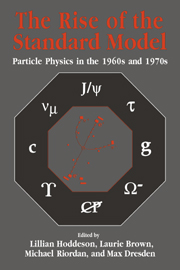Book contents
- Frontmatter
- Contents
- Contributors
- Editors' Acknowledgments
- Photographs of the Symposium
- Abbreviations and Acronyms
- Mathematical Notation
- Part One Introduction
- Part Two Quarks and Leptons
- Part Three Toward Gauge Theories
- Part Four Accelerators, Detectors, and Laboratories
- Part Five Electroweak Unification
- 23 The First Gauge Theory of the Weak Interactions
- 24 The Early History of High-Energy Neutrino Physics
- 25 Gargamelle and the Discovery of Neutral Currents
- 26 What a Fourth Quark Can Do
- 27 Weak-Electromagnetic Interference in Polarized Electron–Deuteron Scattering
- 28 Panel Session: Spontaneous Breaking of Symmetry
- Part Six The Discovery of Quarks and Gluons
- Part Seven Personal Overviews
- Index
25 - Gargamelle and the Discovery of Neutral Currents
Published online by Cambridge University Press: 03 February 2010
- Frontmatter
- Contents
- Contributors
- Editors' Acknowledgments
- Photographs of the Symposium
- Abbreviations and Acronyms
- Mathematical Notation
- Part One Introduction
- Part Two Quarks and Leptons
- Part Three Toward Gauge Theories
- Part Four Accelerators, Detectors, and Laboratories
- Part Five Electroweak Unification
- 23 The First Gauge Theory of the Weak Interactions
- 24 The Early History of High-Energy Neutrino Physics
- 25 Gargamelle and the Discovery of Neutral Currents
- 26 What a Fourth Quark Can Do
- 27 Weak-Electromagnetic Interference in Polarized Electron–Deuteron Scattering
- 28 Panel Session: Spontaneous Breaking of Symmetry
- Part Six The Discovery of Quarks and Gluons
- Part Seven Personal Overviews
- Index
Summary
Several accounts have been written of the discovery of neutral weak currents, mainly by social scientists or theoreticians. Although doubtless well motivated, these authors were themselves not immersed in the experimental situation in neutrino physics in the 1960s and 1970s. There have also been, of course, nonhistorical reviews of the physics of neutral currents. In this chapter I shall present an experimenter's account of the sequence of events in this discovery, based on my own experience and on discussions with other physicists taking part in those experiments. As emphasized earlier in this volume by Leon Lederman (see Chapter 6), discoveries in high-energy physics are frequently stories of false trails, crossed wires, sloppy technique, misconceptions, and misunderstandings, compensated by the occasional incredible strokes of good luck. Certainly this was the case for neutral currents.
It is well known that neutral currents were discovered in 1973 by a collaboration operating with the bubble chamber Gargamelle at the CERN Proton Synchrotron. Gargamelle (shown in Fig. 25.1) was a large (4.8 m long, 1.9 m diameter) heavy-liquid chamber filled with freon (CF3Br) with 20 tons total mass. For the neutral-current investigation, a relatively small fiducial volume of 3 m3 (4.5 metric tons) was employed. The chamber was conceived and constructed by André Lagarrigue with the help of engineers from Saclay, and funded largely by the French atomic energy commission. Other physicists participating included André Rousset and Paul Musset, who were prominent in the subsequent physics program at CERN.
- Type
- Chapter
- Information
- The Rise of the Standard ModelA History of Particle Physics from 1964 to 1979, pp. 428 - 446Publisher: Cambridge University PressPrint publication year: 1997
- 2
- Cited by



